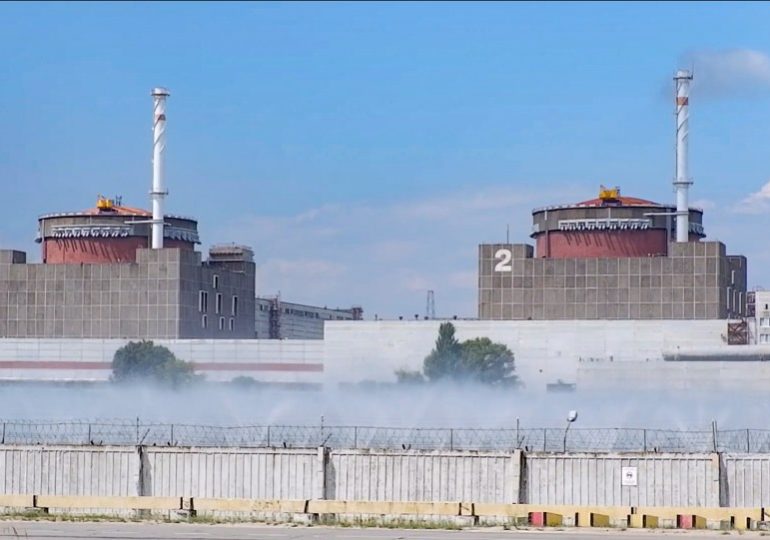LEAKING, land-mined and long feared to be a terror target for Vladimir Putin, Europe’s biggest nuclear plant is stuck in a warzone and on the brink of disaster.
Inspectors inside the Russian-occupied Zaporizhzhia Power Station are warning that the site is spiralling towards catastrophe.
EPAThe Zaporizhzhia nuclear plant has been under Russian control since March, 2022[/caption]
Specialist teams practising decontamination procedures at the plant in case of a radioactive meltdown or blast
Zaporizhzhia is the largest of Ukraine’s four nuclear power plants, which together used to provide about half the country’s electricity.
It has been under Russian occupation since its forces captured it on March 3, 2022 during the opening days of Russia’s full-scale invasion.
During a brief siege, Russian tanks fired on the plant and its administrative buildings. And in the months that followed, Russia weaponized the site.
Landmines have been planted on its perimeter and inspectors have claimed offensive weapons and ammunition are believed to be stored on site – breaching international law on nuclear safety.
Officials in Ukraine have also claimed bombs have been placed in the reactors, which could trigger a disaster ten times more devastating than Chernobyl in 1986.
The International Atomic Energy Agency (IAEA) does not have the power to enforce the rules of nuclear safety, but their inspectors have been stationed at the plant for 16 months.
Their reports paint a distressing picture – leaking safety systems, insufficient staff numbers, no maintenance plan from 2024 and a risk of economic terrorism.
And the alarm bells had already been sounding.
Last summer, workers at the plant called it a catastrophe “waiting to happen” – reporting the state of degradation at the site was not far off a Chernobyl.
It is also feared to be a major terror target.
President Volodymyr Zelensky last summer issued repeated warnings that Russia was planning a terror attack on the Russian-controlled Zaporizhzhia nuclear plant.
His intelligence agency claimed Russia was planning to trigger a minor explosion – which would not blow the entire plant – and make it appear that Ukraine forces were responsible.
In July, staff at the plant held chilling nuclear disaster drills at and around the vast complex.
Nuclear experts have said that a major blast at the plant would affect a billion people across 40 countries.
Last month, head of the IAEA Rafael Grossi warned of the pressing dangers.
Asked on a scale of one to ten – “ten being the most dangerous and one being secure” – what he would rank Zaporizhzhia, he said: “I think there are days where you are near ten, and there are days that nothing seems to happen – and the problem is this.
“The complete uncertainty because this is a war.”
Here are four of the likeliest scenarios that could lead to a nuclear disaster at Zaporizhzhia.
1. Radioactive leak
Either by an accident or by an act of international sabotage, a release of radioactive steam or water could contaminate the area with radiation.
This could then easily infect the water supply – killing thousands.
However, the threat level was far higher last year before the huge nearby Kakhovka Reservoir was drained in June 2023 after the blowing up of the Kakhovka Dam.
A radioactive leak could have contaminated the entire reservoir – one of the largest in Europe – which over 700,000 Ukrainians depended on for drinking water.
2. Breach or loss of coolant
Zaporizhzhia has a large onsite storage for spent nuclear fuel, which requires constant cooling and containment.
Without circulation or cooling, the used nuclear fuel would heat up and burn quickly through its container.
A worst case scenario could see radioactive material spread heavily over the local area, which could then be picked up by the wind and spread to further areas.
3. Meltdown
The plant does not have all of its safety systems in place, but is still heavily guarded from the risk of a meltdown.
Although it would be incredibly unlikely, a full meltdown – significantly worse than the Chernobyl nuclear disaster in 1986 – is theoretically possible.
In that scenario, the radiation would impact all of Ukraine, parts of Russia and large swaths of eastern and central Europe.
4. Economic terrorism
Experts told Pravda that the likeliest scenario would be Russian-occupying forces intentionally contaminating the reactor vessels, which would lead to the plant being shut down.
Releasing radiation anywhere on the site would not pose a threat to the outside world, but it would make the plant enviable and too dangerous to repair.
AlamyPresident Zelensky warned in the summer that Russia was planning a terrorist attack at the plant – unleashing radioactive material[/caption]
APZaporizhzhia has been mined by Putin’s forces and suffered from shelling[/caption]
ReutersIt is the largest power plant in Europe covering 8million sqm[/caption]
Current dangers
Current reports conducted at Zaporizhzhia say that three nuclear reactors have various dangerous leaks that Russia doesn’t plan to fix.
When the IAEA reported on the leaks in January, they were barred from the sites for almost two weeks.
The plant is also suffering from an unreliable power connection, which are essential to be maintained in case a nuclear reactor needs to be “shut down”.
Power is also needed to circulate cooling water in the reactors – without it, a nuclear meltdown can start within 27 hours.
Since Russia’s hostile takeover, the power plant has lost all external power eight times so far.
In March, 2023, Russian shelling of the right bank of the Dnipro river damaged the plant’s energy infrastructure. Technicians were unable to repair the damage while the fighting continued.
Three months later, IAEA staff were still barred by Russia from making the repairs.
Since then, the plant has intermittently lost or had its power turned off, which shuts down vital cooling circuits – leaving it in perilous conditions.
There is also a major staffing crisis at Zaporizhzhia . Before the war, the plant had 11,500 workers. Now, it has barely 4,500.
Ukrainian employees and their families have been interrogated, kidnapped and tortured. Some have disappeared.
It comes as The Sun wrote a harrowing dispatch from the Zaporizhzhia region where a frontline Ukrainian town is making its final stand against Putin’s forces.
There are just 800 people left in Stepnohirsk, which is being pummelled by Russian bombs – but its last residents have refused to abandon it.
Just a few miles from the Ukrainian counteroffensive line in the Zaporizhzhia region, there is no work, drinking water, or heating system, and shelling rarely stops.
The last survivors of Stepnohirsk are the elderly, disabled, and their relatives who take care of them.
Despite the Kremlin’s recent gains, Ukraine is managing to cause major damage to Putin’s war efforts by daring and inventive air, land, and sea attacks.
ReutersThe site is suffering from unreliable power supplies, insufficient staffing and leakages[/caption]
ReutersA nuclear meltdown would be the worst case scenario[/caption]
ReutersExperts claim that Russia could plan to contaminate the reactors[/caption]
Leave a comment








